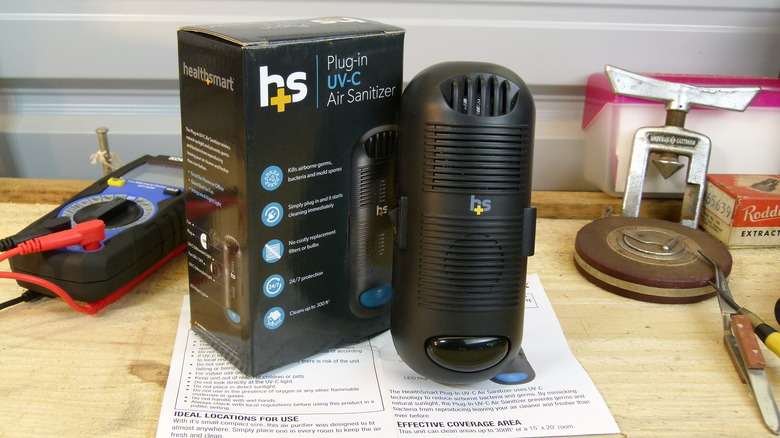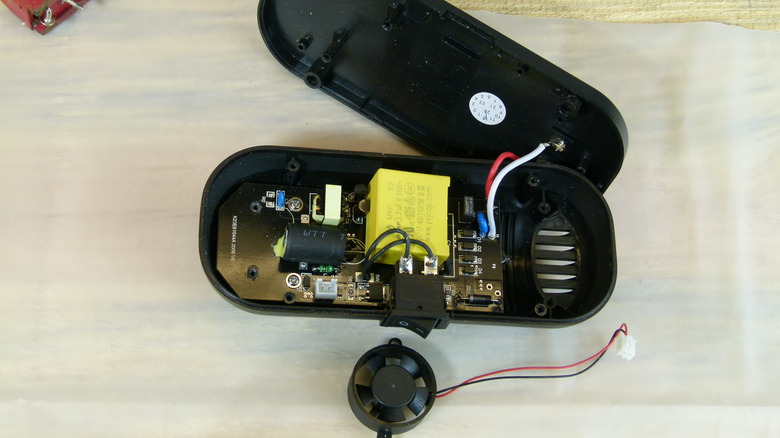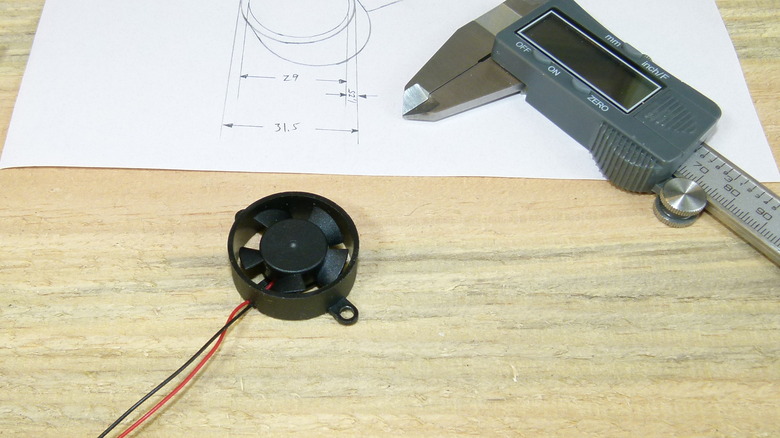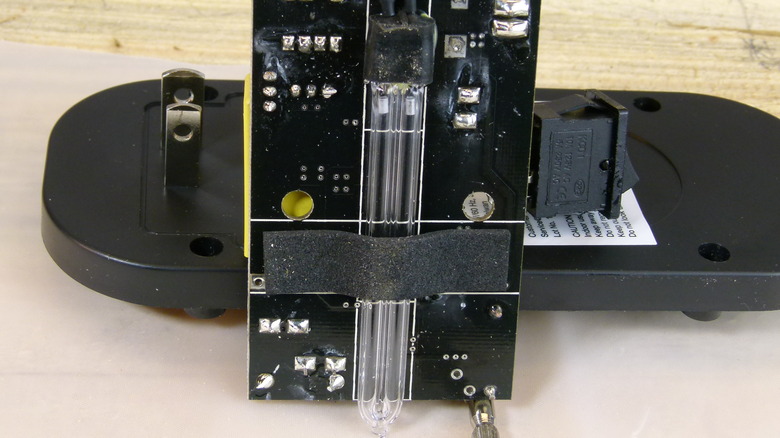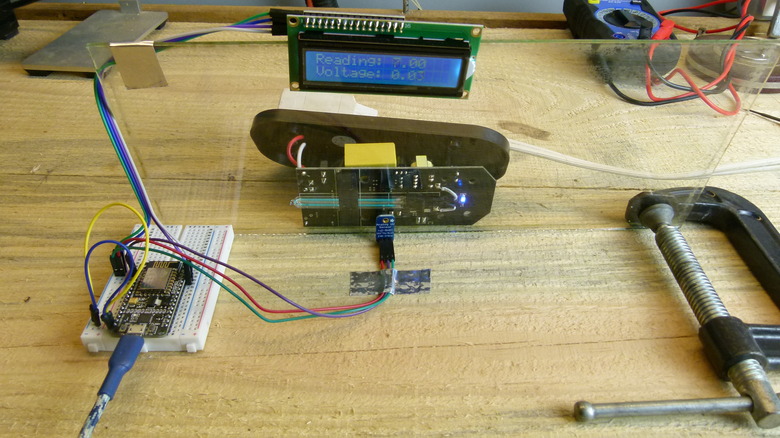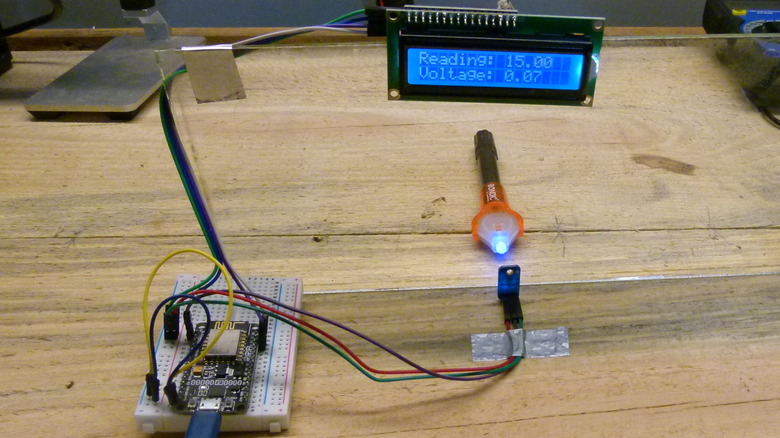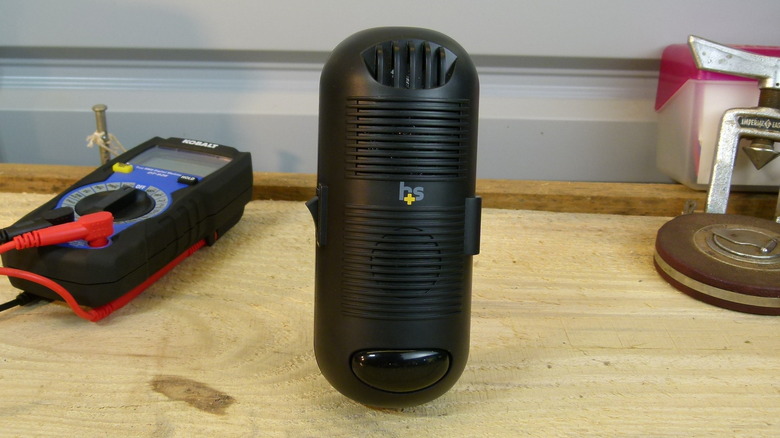We Tried The Cheapest Air Purifier At Lowe's. Here's How It Went.
When you set out to buy the cheapest version of something, it's natural to expect things to get a little less complicated. There are fewer decisions to make, and lowered expectations translate into a certain amount of tolerance for any shortcomings that thing might present. And so was our feeling when we picked up the HealthSmart 1-Speed True HEPA and UV Air Purifier we had ordered online from Lowe's for $23.95.
The only real decision we had made at that point was to exclude the unfortunately named Midigitel air purifier because it is meant for use in a car to remove cannabis smoke, which we were not prepared to test, having finished college some years before. Otherwise, with the HealthSmart in hand, we were ready to take a deep, purified breath and start testing. What could complicate things for us?
The first sign of trouble was actually in the product description on the Lowe's website. But we'll get to that. So far we were simply admiring the product design based on the photo on the retail box. The HealthSmart looks fairly polished in an air cleaner space that is littered with interesting design choices that include air purifiers that could double as bread machines, gaming PCs, composting toilets, giant shavers, a '70s auto battery charger, the front third of a custom shop hotrod, and an 18-pack of what appear to be cages designed for the transport of radioactive ferrets.
Meet the HealthSmart Air Sanitizer
The packaging of the $23.95 HealthSmart purifier makes a few claims and seems to studiously omit others. One such omission is a failure to mention anything about the "true HEPA" filtration mentioned in the Lowe's product name and specifications. We should have been clued in from the boast about requiring "no costly replacement filters," since HEPA is a filter technology.
What specifically the device planned to do with its UV light was not clear, but it would do it in a 300-square-foot room. A diagram on the Lowe's site shows two UV-C lights in a louvered black plastic case, so its mission appeared to be to kill airborne microbes using ultraviolet radiation. This was a little puzzling in at least two ways. First, UV-C germicidal devices have been around for a while, but those with an exposed bulb are typically designed to be mounted in ductwork or above the heads of room occupants. Second, it wasn't clear from the product description whether the HealthSmart would simply be killing the offending mold, bacteria and viruses, interfering with their reproduction, or both.
Whatever the specifics, we were assured that the little black capsule would take the nasties out of our air. In fact, one of the many product websites (and definitely the strangest) for this air sanitizer calls it a "UV Vaccine." The same page, a bit farther down, declares "We Are Not Murderers" in the headline for an odd statement about working with, not against, nature.
How to test a 'UV Vaccine'
We had a number of things to test in order to determine if the HealthSmart sanitizer was living up to its promises. One (from yet another product website) is to clean using "negative ions." This threw up a red flag for us, since ionic air cleaners are often responsible for contributing to dangerous ozone levels in homes (via the EPA). UV-C light does not generate ozone. We needed to verify that we were dealing with UV-C, so we devised a test similar to the one described on the Adafruit blog, using a GUVA-S12SD UV sensor.
UV-C light is, itself, rather dangerous. We hoped the UV sensor would also shed some light... err, illuminate... umm, clarify whether the HealthSmart bulb is safe to operate at the 12 to 16-inch height of the usual mains receptacle.
As for cleaning, we wanted to know if the device lowered the number of PM1 and PM2.5 particles (with a size of .1-1 and 1-2.5 microns, respectively) in the test room's air. It's never entirely clear from the descriptions of the HealthSmart sanitizer what kind of reduction in microbes should be expected, but we anticipated that it should be at least statistically significant. We would employ two air quality sensors (GP2Y1010AU0F and DSM501A, if you're keeping score at home) to do the job.
We also planned to have a look inside the device and look up what components we could identify, in order to explain our other findings if necessary.
How it exceeded expectations
The first thing you notice about the HealthSmart sanitizer is that you don't notice it. When you plug it in and turn it on, there's no immediate clue (other than the tiny blue LED nightlight that's built in) that anything is happening. This is partly because the UV light (there is just one, regardless of the diagram mentioned earlier) takes a while to warm up and turn on, but mainly because the built-in fan is virtually silent — so silent, in fact, that there's a video on the Lowe's site to explain which switch position is "on" and which is "off." The video then further delves into the matter (a bit defensively) by explaining the quietness of the fan as a good thing. And intentional. Yes, most definitely intentional.
Our teardown revealed that the fan is a 40x10 mm brushless 6v model supplied by Wang Li Xin electronics. While we had the sanitizer apart, we powered it on to verify that the fan was actually working, which it was, and silently, even outside of the enclosure.
The size, specs and quietness of the fan made us curious about its efficacy in moving air around a 300-square-foot room. We couldn't find information on that particular model, but we looked into a number of fans in its class to determine the airflow rate (expressed in CFM, or cubic feet per minute) of similar fans. And we investigated what sort of airflow would be required to do the job.
How it could be improved if it were completely different
This is where things started to get interesting, and complicated. We averaged the CFM ratings for all 30 mm fans less than 12 volts sold by Newark, which came out to be just short of 4 CFM. We further learned that air purifiers have between 2 and 6 ACH ratings, meaning that they can change the air in a room two to six times per hour, per Home Air Guides. Some quick work with a CFM calculator showed us that our fan's likely CFM of around 4 was more appropriate for a 15-square-foot room than a 300-square-foot one (via Learn Metrics HVAC Systems). So it doesn't seem likely this device is capable of doing its job from an air movement perspective.
We chose to focus on the more flexible DSM501a sensor to determine particulate air quality changes throughout our testing. Unsurprisingly for a filterless device with only 12 hours to work, the difference was negligible. Both readings decreased, but only by .25% for PM1 particles and .09% for larger PM2.5 particles. Because the HealthSmart isn't a particulate filter and because our starting numbers were already very low, we decided little could be concluded from the air quality tests.
Two wrongs don't make an air sanitizer
Turning to the UV light itself was reassuring at first. The sort of testing we were doing would reveal if we weren't really dealing with a UVC bulb. Things were about to get interesting again, already. With both the HealthSmart bulb and our control, the UV LCD from a Bondic plastic welder, we saw glass filtering the UV light in a way that was unlikely with a fake UV-C bulb. This was in keeping with the sanitizer's CARB certification, which determined that it wasn't producing too much ozone. A piece of glass inserted between the lamp and sensor almost entirely removed any trace of sensor readings, indicating that the lamp is probably within the UVC spectrum.
But we also noticed that the bulb in the HealthSmart produced readings that dropped to ambient levels at about the same distance as the small LED in the Bondic device, around 4 inches. We investigated and found there's reason for concern about the lamp being insufficiently powerful, but an RTI International report suggests that repeated exposure in a recirculating environment is as effective as better bulbs.
Would we buy it again?
Which brings us back to the fan. Since the bulb appears to be underpowered and the fan — a 30 mm, 6-volt, .06-amp model — likely can't move enough air to drive a UVC air sanitizing mechanism, it simply doesn't seem likely that this device works well. Every website, certification, and mention of this device seems to involve a different company name, but once you track everything down you find that there is either a great deal of confusion about how this product should work, or perhaps there is some attempt to mislead.
We've talked about the manufacturer's website implying that this is an ionic air cleaner, though it is clearly a UV-C purifier. There's also the matter of the product's ETL listing. ETL is equivalent to a UL listing, but this device was tested as an electric fan using the UL-507 standard, rather than UL-2998, which covers electronic air purifiers and requires that the tested product produce no ozone at all.
These discrepancies might all be in good faith, like Lowe's calling it a HEPA filter likely was. But there's enough noise in the details and cause for concern that it seems another product might be a better bet if you want zero ozone emissions. If you want to do business with a company that declares its commitment to zero murders, on the other hand, HealthSmart might be the one for you.
